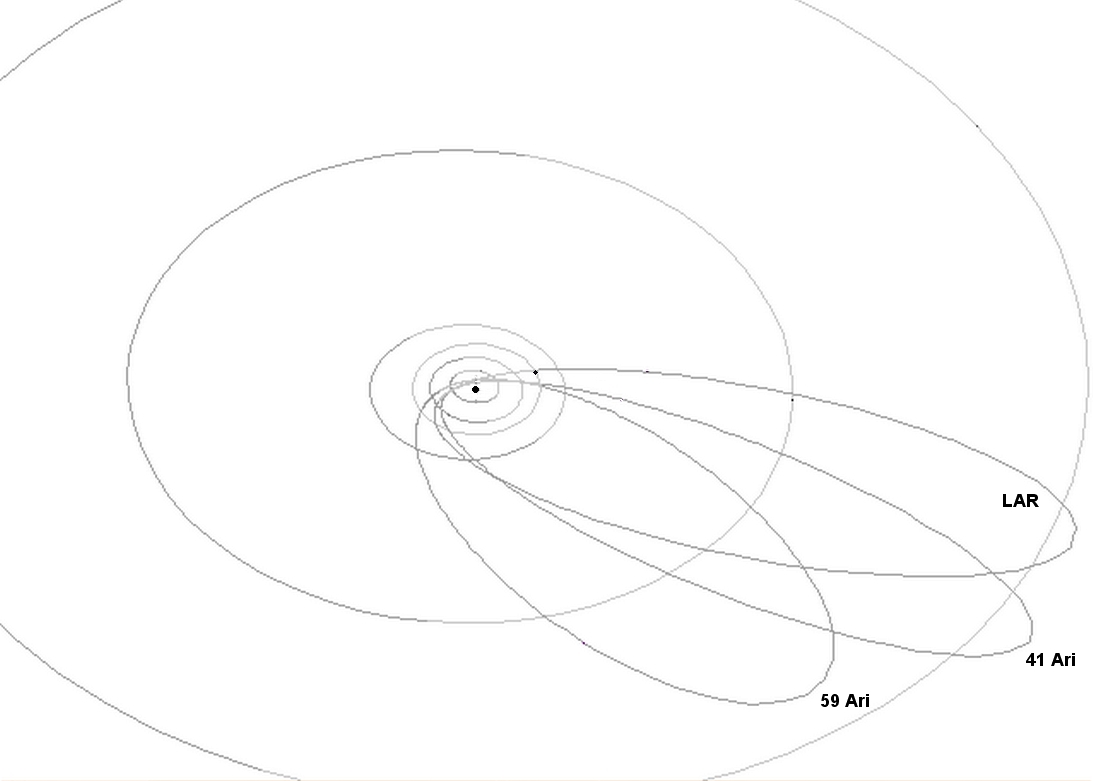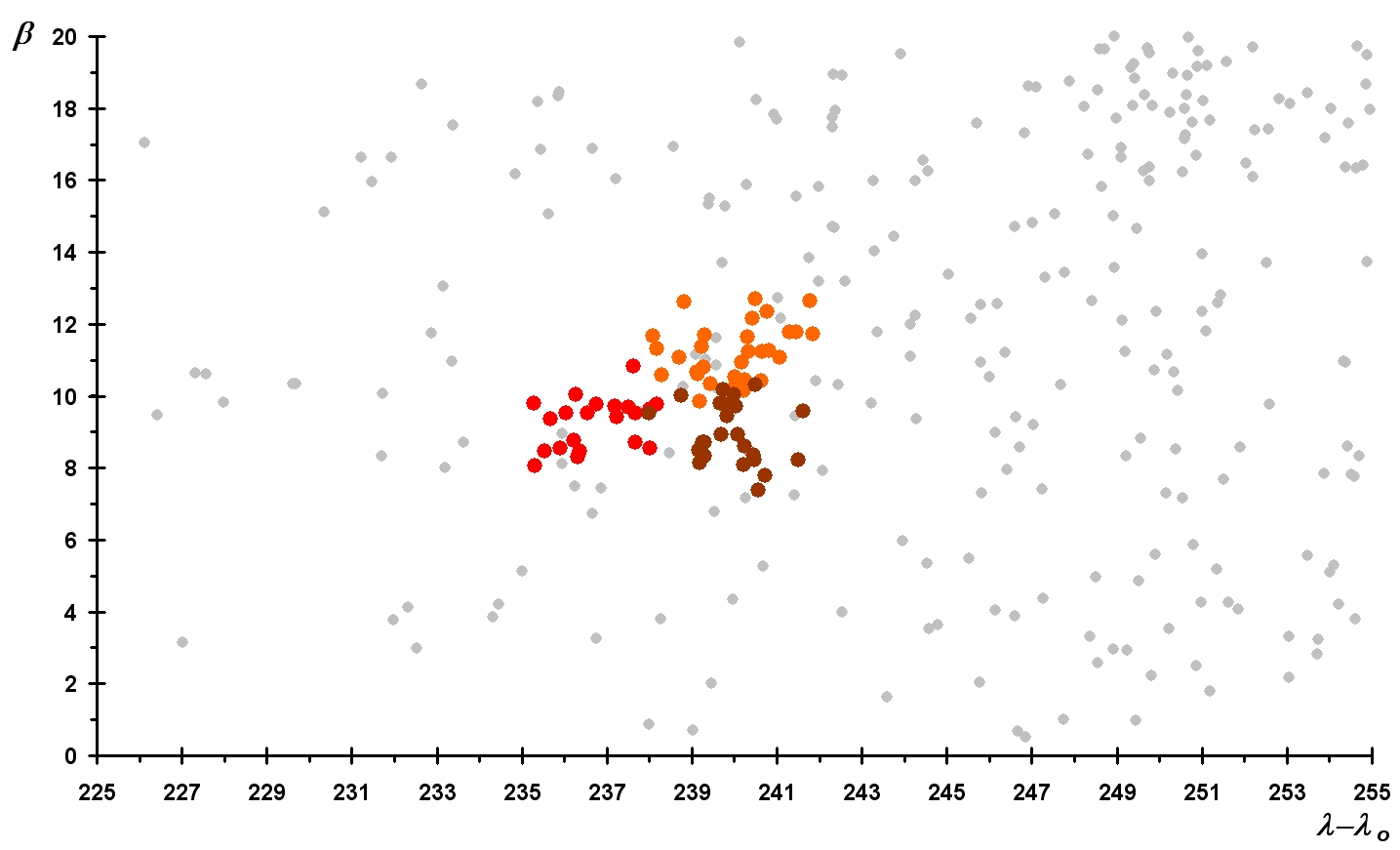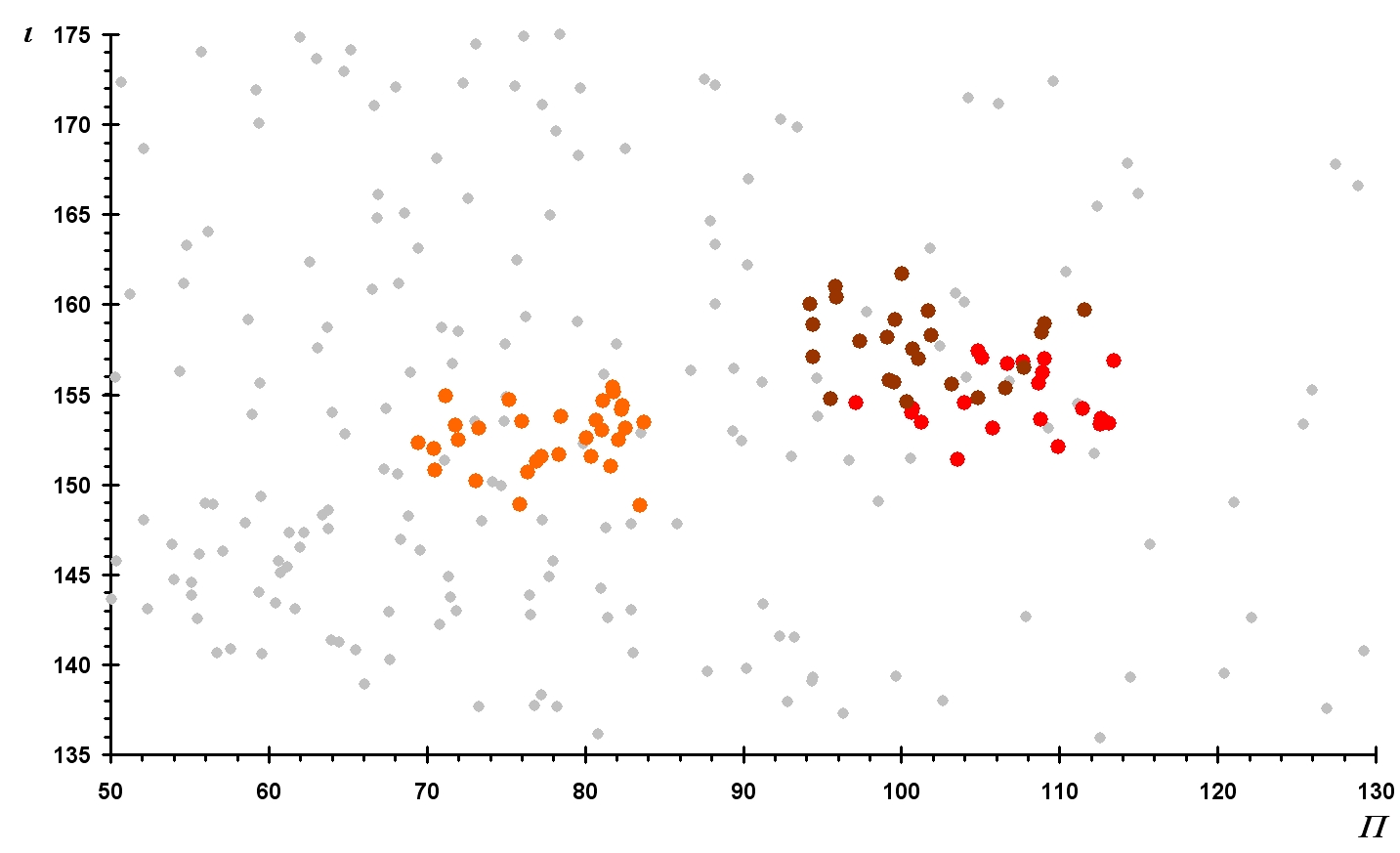Two radiant clusterings are noted in UKMON data near 41 Arietis, whilst D criterion analyses show two discrete showers, and to a far lesser extent the somewhat earlier and even more discrete λ Arietids, the overall similarities of these three suggest that they may have a common long past parent body from which meteoroid orbits have changed over time.
1. Introduction and methodology
The sheer continual increase in number of meteor orbits available over the past decade or so can lead to it being difficult to assess radiant clustering of minor sparse showers and avoiding false positives. At times it can be useful to use relatively homogeneous sets of data from one source (relative in the sense that equipment and processing algorithms for most groups have evolved over time) and then testing any potential clustering via orbital similarity analyses using the complete collection of publicly available meteor orbits, or at least optically derived ones.
Examination of areas of apparent radiant clustering amongst UKMON sporadic meteor orbits (Campbell-Burns and Kacerek, 2014) showed a mild overdensity near to one end of the constellation Aries. However D criterion analysis (Jopek, 1993), henceforth denoted DJ, demonstrated that despite the similarity in clustering there were two adjacent showers that although similar where quite distinct from each other, with the relation DJ = 0.244 for their mean orbits being much higher than the canonical 0.105 stated by Jopek (2013) as the initial threshold value for likely connectivity (where the lower the DJ value between two compared orbits the better the likelihood of non-random association). Also, the relatively high retrograde inclination of the orbits precluded any circumstance derived orbital similarity such as that which can be found in showers derived from Jupiter Family Comet parent bodies.
Meanwhile, a not-too-distant published meteor radiant, the λ Arietids (Jenniskens et al., 2016), henceforth LAR, although quite markedly distinct being up to 20° in both solar longitude and right ascension distance (that is both temporally and spatially) nevertheless has some commonality amongst some of its orbital elements. Yet the DJ values of the LAR orbit relative to the two new apparent streams are quite distinct at 0.309 and 0.212 respectively, albeit ironically with the shower most distant in time and space from the LAR having an orbit better matching than it does its spatial and temporal twin.
Accordingly, DJ analyses were made upon the mean orbital particulars of all three showers using data from multi-station meteor survey publicly available data archives of SonotaCo Network (e.g., SonotaCo, 2009), CAMS (e.g., Jenniskens et al., 2018), EDMOND (e.g., Kornoš et al., 2014) and Global Meteor Network (Vida et al., 2019a; 2019b), with the published orbit for the LAR being used as the analysis seed in that case. For the other two showers a span of right ascension and declination and solar longitude was culled from the UKMON subset and the means of both clusterings used as an orbit seed. The mean orbit derived from that processing was then freshly used as a new seed giving more and better matches and this led to the following results.
2. Results
The results gave over 50 distinct meteors for each of the three showers to a better than DJ 0.100 level, with the two new potential showers henceforth referred to as the 41 Arietids (41 Ari) and the 59 Arietids (59 Ari) respectively for convenience. To add a further level of rigor to the investigation only the objects for each shower matching the mean to better than 0.080 were kept for the final examination leading to 24, 21 and 30 meteor orbits for the 41 Ari, 59 Ari and LAR respectively. None of the resulting meteors in any particular one of the showers was common to any meteor in either of the other showers. Throughout it should be remembered that the surveys are predominantly biased towards the detection of bright optical meteors, and in the following the mean magnitudes and standard deviations for the 41 Ari, 59 Ari and LAR are –0.7 ± 1.3,
–0.7 ± 1.3 and 0.3 ± 1.4 respectively.

Figure 1 – The mean orbits for all three showers, with the more circular orbits representing planets out to and including Saturn, all to scale for a representative date of 1st September 2022. Darker grey parts of the orbits and lighter grey parts of the orbits represent above ecliptic and below ecliptic parts of the orbits respectively, with the position of the Sun and the Earth being shown in black.
Table 1 gives the particulars of each shower based upon a mean and standard deviation, whilst Figure 1 illustrates these mean orbits with respect to each other. Figure 2 demonstrates their relation in terms of ecliptic latitude and Sun centered ecliptic longitude whilst Figure 3 does the same in terms of orbital inclination and longitude of perihelion. In each figure a background of UKMON sporadic meteors is included to highlight the nature of the showers with respect to the general background for the same spatial and temporal ranges as denoted by the axes of the plots.
| Shower | R.A. | Decl. | λ | q | e | i | ω | Ω | λ | β | λ – λʘ | Π |
| 41 ARI | 43.4 ± 2.8 |
26.3 ± 0.9 |
172.0 ± 2.9 |
0.305 ± 0.016 |
0.962 ± 0.021 |
154.7 ± 1.8 |
295.0 ± 2.0 |
172.0 ± 2.9 |
48.7 ± 2.6 |
9.3 ± 0.7 |
236.7 ± 0.9 |
107.0 ± 4.6 |
| 59 ARI | 50.1 ± 2.7 |
27.7 ± 1.0 |
175.0 ± 2.7 |
0.382 ± 0.012 |
0.946 ± 0.023 |
157.8 ± 2.1 |
286.0 ± 2.6 |
175.0 ± 2.8 |
54.9 ± 2.5 |
9.0 ± 0.8 |
239.9 ± 0.8 |
101.0 ± 5.0 |
| LAR | 28.2 ± 2.3 |
23.6 ± 1.0 |
154.6 ± 2.5 |
0.407 ± 0.024 |
0.950 ± 0.023 |
152.6 ± 1.7 |
283.1 ± 1.7 |
154.6 ± 2.5 |
34.6 ± 2.3 |
11.2 ± 0.8 |
240.0 ± 1.0 |
77.7 ± 4.5 |
Table 1 – The mean and the standard deviation on the mean of the meteor orbits for all three showers are given for :- right ascension (in degrees); declination (in degrees); solar longitude, λʘ, (in degrees); perihelion distance, q, (AU); eccentricity, e; inclination, i, (in degrees); argument of perihelion, ω, (in degrees); ascending node, Ω, (in degrees); ecliptic longitude, λ, (in degrees); ecliptic latitude, β, (in degrees); ecliptic latitude minus solar longitude, λ – λʘ, (in degrees) and longitude of perihelion, Π, (in degrees).

Figure 2 – The ecliptic latitude, β, and Sun centred ecliptic longitude, λ – λʘ, both in degrees, for the 41 Arietids, red, 59 Arietids, brown, and, the λ Arietids, orange, with the UKMON sporadic meteors covering the same full range of solar longitude also shown in grey.

Figure 3 – The orbital inclination, i, and longitude of perihelion, Π, both in degrees, for the 41 Arietids, red, 59 Arietids, brown, and, the λ Arietids, orange, with the UKMON sporadic meteors covering the same full range of solar longitude also shown in grey.
3. Discussion
The distinctness of the three showers is demonstrable, yet at the same time the similarities of the showers, especially with respect to the background, cry out against coincidence. Nevertheless, said distinctness within the orbital and/or spatial/temporal parameters suggests against this being one long duration stream with attendant radiant drift given the gap in meteors between the LAR and the mutually temporally and spatially adjacent 41 Ari and 59 Ari, whilst ironically the most distant apart showers in those parameters, the 59 Ari and the LAR, have greater similarity in orbital parameters than they do with the 41 Ari. The similar inclination for all three showers leads to the geocentric velocities overlapping at 61.0 ± 0.6, 62.4 ± 0.6 and 62.2 ± 0.4 km/s respectively.
Jenniskens et al. (2016), in their comments for their LAR shower (this was the discovery publication for that shower, derived from 11 orbits), state that that shower is an apex shower likely derived from a long period or possibly Halley type comet. If this is the case it is not difficult to imagine this relatively minor and sparse trio of streams, having drifted or precessed over time, although that does not explain the gap in time and space between the LAR and the other two showers, as well as the mutual distinctness of the latter, nor is it a quantitative assessment (the latter is beyond the remit of these analyses).
One evident trend is a decrease/increase in the mean perihelion distance between the three distinct mean orbits without any overlap in standard deviation (although the 59 Ari and LAR come very close to overlapping), which could be interpreted as a spread due to solar radiation pressure (which can both decrease and increase the size of an orbit but not necessarily affect its orientation) and/or orbital precession. This again is not reflected by the lack of continuity across the data, each being distinct and with a conspicuous gap in distribution of radiants between the LAR and the two new and overlapping showers, more suggestive of orbital shifts related to gravitational interactions during planetary close approaches. Further, any putative evolution due to precessional effects suffers from the fact that the mean orbit of the smallest perihelion stream lies between the other two orbits, and thus at some point the orbit would have had to precess in two opposing directions unless the apparent perihelion drift can be shown not to be connected with change in orbital shape and orientation.
There are reports of meteor complexes which suggest some streams belong to “families” of streams, however the group of showers here could not only be taken as siblings, but rather as snapshots of a single shower’s orbital evolution over time. Yet again this leaves the issue of lack of any smooth and gradual spread of meteoroids along a contiguous continuity of orbital parameters. No real proximity of any of the orbits’ aphelia suggest any close approaches to the massive outer planets either, for despite all mean orbits just crossing the orbit of Saturn their inclinations are large relative to the ecliptic plane.
The assumption of the three showers being derived from a common parent body is taken here, with one apparition of the comet leading to all three streams being due to orbital evolution of an initial meteoroid stream, as the likely long to very long period of any such parent body is likely to be far too long for meteoroids derived over three apparitions widely separated in time to not have dispersed by now and all still be extant.
Such assumptions would need to be tested for any validity by those more capable of deriving the orbital evolution of meteoroid streams over long time periods.
4. Conclusion
Examination of a relatively homogeneous collection of data from UKMON lead to the noting of radiant clustering in Aries around mid-September. Further exploration upon the orbital elements using DJ criterion led to two discrete showers, one centered just South of 41 Arietis and the other centered very near to 59 Arietis, which although marginally overlapping in time and radiant were also distinct in orbit. Although some similarities could be seen with the late August λ Arietids there existed not only a marked temporal and spatial offset but further said offset represented a complete gap between this shower and the two putative new ones.
Given the past claim of the λ Arietids being an apex shower likely derived from a long period comet the assumption is taken that all three showers shared the same parent body, possibly even originally from just one apparition, that has evolved into the present triad over time. The discrete nature of the three showers, with no sharing of meteoroids when utilizing DJ criterion testing upon their mean orbits, as well as the gaps in radiants and at times peak meteor periods, along with the the lack of smooth orbital continuity, suggest that if they are from a past common source subsequent orbital changes should be due to gravitational interaction with other bodies as opposed to solar radiation (whether electromagnetic or the solar wind) or precessional effects.
However, a quantitative numerical analysis of the three sets of orbits would be required to assess any validity in the assumption that one historic stream became three discrete streams.
All that can be said with some surety now is there are three discrete but nevertheless strongly similar streams in Aries from latest August to mid-September.
Acknowledgments
The meteor survey groups and especially their volunteers and operatives are expressly thanked not only for their work but for making their data public and thus available for analytical examination by all instead of just wallowing in a private archive. The individual groups are mentioned in the body text of the article and fully referenced below.
Strangely, for the case of public domain scientific data, the Global Meteor Network (GMN) and UKMON data are released under the following licence.
References
Campbell-Burns P., Kacerek R. (2014). “The UK Meteor Observation Network”. WGN, Journal of the International Meteor Organization, 42, 139–144.
Jenniskens P., Nénon Q., Gural P. S., Albers J., Haberman B., Johnson B., Morales R., Grigsby B. J., Samuels D., Johannink C. (2016). “CAMS newly detected meteor showers and the sporadic background”. Icarus, 266, 384–409.
Jenniskens P., Baggaley J., Crumpton I., Aldous P., Pokorny P., Janches D., Gural P. S., Samuels D., Albers J., Howell A., Johannink C., Breukers M., Odeh M., Moskovitz N., Collison J., Ganju S. (2018). “A survey of southern hemisphere meteor showers”. Planetary Space Science, 154, 21–29.
Jopek T. J. (1993). “Remarks on the meteor orbital similarity D-criterion”. Icarus, 106, 603–607.
Kornoš L., Koukal J., Piffl R., and Tóth J. (2014). “EDMOND Meteor Database”. In, Gyssens M., Roggemans P., Zoladek, P., editors, Proceedings of the International Meteor Conference, Poznań, Poland, Aug. 22-25, 2013. International Meteor Organization, pages 23–25.
SonotaCo (2009). “A meteor shower catalog based on video observations in 2007-2008”. WGN, Journal of the International Meteor Organization, 37, 55–62.
Vida D., Gural P., Brown P., Campbell-Brown M., Wiegert P. (2019). “Estimating trajectories of meteors: an observational Monte Carlo approach – I. Theory”. Monthly Notices of the Royal Astronomical Society, 491, 2688–2705.
Vida D., Gural P., Brown P., Campbell-Brown M., Wiegert P. (2019). “Estimating trajectories of meteors: an observational Monte Carlo approach – II. Results”. Monthly Notices of the Royal Astronomical Society, 491, 3996–4011.





